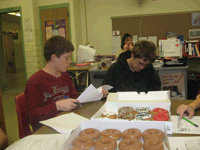When speaking to teens , Ruth Llewellyn, Behavior Health Specialist at Greenleaf, says she has found that anger issues are often tied to some kind of grief or loss - not necessarily related to a death but often from parental abandonment and rejection.
“We use the Antwone Fisher movie. It really helps illustrate those issues of loss and abandonment from parents and how it affected him and his anger issues,” Llewellyn said.
Antwone Fisher, the movie, is a true story of a young man who grew up in foster homes, was physically, verbally, and sexually abused and sent to a male institution. After years of pain, he finally found hope. Many of the teens can relate to this story.
“Their loss could be through parental absence due to involvement in substance abuse, or financial poverty, or having to move so many times that they’ve never had a chance to connect to anyone,” Llewellyn said.
Llewellyn has found that anger is an easier emotion for the teens to feel, rather than sadness or depression.

Healing Broken Hearts
In order to bring healing to teens with troubled pasts, different relaxation techniques are offered; one of them being listening to relaxation tapes and classical music with water in the background.
“Whenever we play the music the kids tell us how sad it makes them feel, and that they could start crying,” Llewellyn said.
The teens are given time to relax in the moment and feel the painful side of anger.
“We use the analogy of the onion and the layers, you peel different layers and underneath the anger is pain, sadness or rejection. But the anger makes them feel strong. Though the anger may be functional for a while, it’s destructive to them. So gaining insight into what’s driving the anger really helps them,” Llewellyn continued.
Another benefit of the group setting is finding out that they aren’t the only ones dealing with such tremendous pain, but that other kids have similar grief or loss issues.
“It’s powerful for them to recognize how they’re all letting their anger become destructive for them,” Llewellyn explained.

Group Therapy
During their “Anger Go-Around”, the teens share with the group a situation where they felt anger, and then rate it on a scale of one to ten; ten being rage. Then they share how they managed it. The goal is to help them look at the different degrees of anger and point out what triggers the different degrees.
Different anger styles used by teens often include Explosive, Passive Aggressive and/or Triangulation, which means bringing another person into the equation to get at someone else.
Following this, they are asked what relaxation technique they used, and whether or not they used cognitive reframing (seeing the situation for what it really is), or if they removed themselves from the situation.
“We want to keep them conscious, not reactive,” Llewellyn said, “When they feel an emotion they feel they have to immediately react and we’re trying to help them slow that down by staying more conscious.”
Oftentimes teens react out of anger without thinking. Techniques offered by Greenleaf raise awareness so they can recognize their emotions and respond in healthier ways.
“Many of them cannot have another offense because it could land them some time in Dan Street Juvenile Detention Center or could have even more severe consequences. Our goal in the 10 weeks is to not have any other anger offense occur for them,” Llewellyn said.

Obstacles
A majority of the teens have some type of ADD, and/or oppositional defiance diagnosis, which means they don’t respect or want to listen to authority.
The first several weeks are a challenge, but Llewellyn says the teens take on a whole new personality by the 5th week.
“In the beginning they’re very rebellious. They’re cautious because they want to make sure that you’re for real, or genuine. They look for that consistency because that’s another thing they don’t have, any stability or consistency in their life,” Llewellyn said.
Transportation is also an issue.
“I don’t think people realize that they might have already ridden the bus an hour or longer to school, then an hour or longer home, and then they have to do it again for group, and again that night when they leave,” Llewellyn explained, “It’s a huge commitment that some of these kids are making consistently.”
Llewellyn shared that some of the teens come soaking wet without adequate clothing or boots during winter.
Some of the teens are also parents, and childcare interferes with keeping their commitment to group.
Positive Results
“We’ve always had very positive results,” Llewellyn said, “Ironically at the end of the 10 weeks they all say how sad they are that it’s ending. A lot of them don’t have someone to listen to them, so that’s a big thing, and they’ve shared a lot of intimate things.”
Some ask to continue on in individual counseling afterwards.
At the end of their journey they have a pizza party and are given a certificate and plaque with their name and a poem on it.
For more information on this program please contact Greenleaf Family Services at 330. 376.9494 or toll free at 800.277.9494 or visit www.greenleafctr.org.
To read Part One of the story click the link.
If you have any story ideas, questions, or comments you can contact me at Katie@akroneur.com.